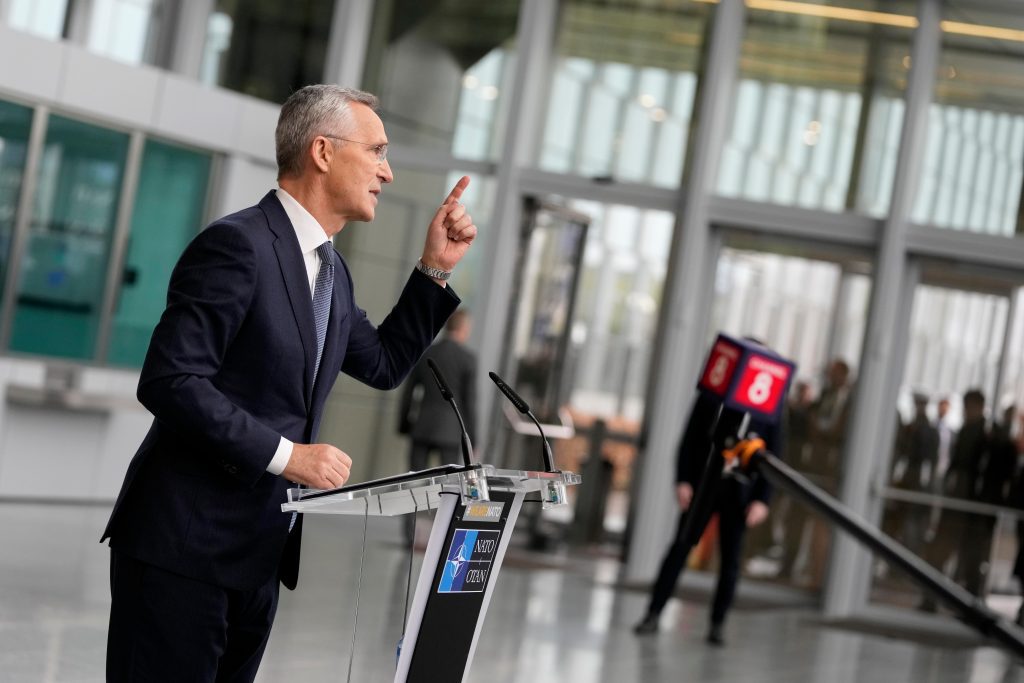By LORNE COOK (Associated Press)
BRUSSELS (AP) — NATO is discussing a plan to offer more consistent military help to Ukraine in the future, as well-armed Russian troops gain control on the battlefield, the top civilian official of the organization said Wednesday.
“We believe that assistance to Ukraine should rely less on short-term, voluntary offers and more on long-term NATO commitments,” said NATO Secretary-General Jens Stoltenberg before leading a meeting of the alliance’s foreign ministers in Brussels.
Earlier on Wednesday, Ukraine reduced the military conscription age from 27 to 25 to fill its depleted ranks after over two years of war. A shortage of infantry along with a severe ammunition deficit has allowed Russian troops to take the lead.
“We are doing this because of the situation in Ukraine. It is serious,” Stoltenberg told reporters. “We see how Russia is advancing, and we see how they are trying to win this war by simply waiting us out.”
The plan involves NATO managing the Ukraine Defense Contact Group — a forum of around 50 countries that has regularly gathered during the war to obtain weapons and ammunition for Ukraine — instead of the U.S. European Command.
U.S. Gen. Christopher Cavoli serves as NATO’s top military commander as well as the head of U.S. European Command, so the leader in charge would not change. But Stoltenberg stated that a formal “institutional framework” is necessary as the war continues, and NATO can provide it.
While this change would not have NATO directly supplying weapons to Ukraine — as an organization with 32 members that operates through consensus, the allies only agree to provide non-lethal assistance such as demining equipment, fuel, and medical supplies — it would represent a new stage in its involvement in the war.
NATO is eager to do more for Ukraine, especially as Russia holds a military advantage, but its members are not prepared to offer the country their ultimate security guarantee: membership. They also do not want to be pulled into a broader conflict with a nuclear-armed military power like Russia.
Under the new plan, expected to be approved by U.S. President Joe Biden and his counterparts at their next summit in Washington in July, NATO would coordinate the military aspect of Ukraine support efforts by evaluating Ukraine’s needs, gathering commitments, and organizing meetings.
The Financial Times newspaper reported that the multi-year plan could involve up to $100 billion, but Stoltenberg declined to provide details.
Western commitments to assist Ukraine have been tainted by unfulfilled promises. A European pledge to provide 1 million rounds of ammunition fell significantly short, and financial aid intended for Ukraine’s war-torn economy was delayed by political disputes in Europe and is still blocked in the U.S.
“It is risky to make promises that we cannot keep,” Belgian Foreign Minister Hadja Lahbib told reporters when asked how much her country might be willing to contribute to a $100-billion fund. She stated that the plan requires further discussion.
Stoltenberg once again asked Congress to resolve its disagreements and approve an extra spending bill, which includes about $60 billion in military assistance for Ukraine. He said that the ongoing delay 'has consequences' on the battlefield.
“That’s one of the reasons why the Ukrainians have to limit the number of artillery shells, why they have difficulties facing the Russian force with superior military power,” he said. Russian troops, he added, “are able to outgun them with more ammunition and more artillery.”
___
___
Follow AP’s reporting on the conflict in Ukraine at https://apnews.com/hub/russia-ukraine









